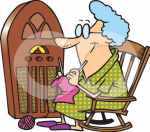AWA Receiving Centre
- at La Perouse
In 1930, In Sydney, on the heights of La Perouse,
overlooking Botany Bay, was located the Sydney Receiving Centre of AWA, the most important and the largest receiving station
in the Southern Hemisphere at the time.
Wireless traffic was received there from a network of stations throughout
the world.
This included messages from ships' stations in the Pacific and Indian Oceans and from the Coastal Radio
Stations on the south-eastern seaboard of Australia.
Two-way wireless telephony conversation was maintained between La
Perouse and the trawlers operating off the N.S.W. coast
The latest news of the world was received from the English high power station
at Rugby, as well as reception of broadcast programmes transmitted from English, American, and Continental high power Broadcasting
Stations.
The enormous ranges by short-wave working was demonstrated by the reception at La Perouse of experimental
communications from short-wave stations in Great Britain and Europe, the United States and Canada, Africa, Asia, and the Dutch
East Indies.
The La Perouse Station maintained communication with all the shortwave stations in the Pacific, including
Rabaul, New Guinea; Suva, Fiji; Noumea, New Caledonia; and San Francisco, while effective communication was also maintained
with ships' stations equipped with shortwave apparatus, crossing the Pacific and Indian Oceans.
The system of centralising
wireless activities was conceived and developed by Mr. Fisk, Managing Director of Amalgamated Wireless (A/asia.) Ltd., which
resulted in there being three large wireless centres in N.S.W.- the Transmitting Centre at Pennant Hills, the Receiving Centre
at La Perouse, and the Control Centre at A.W.A. Headquarters, 47 York Street, Sydney.
The
following services were operated from La Perouse:
The Beam Feeder Service from Melbourne.
The Coastal Radio Service communicating
with The Coastal Radio Stations at Brisbane, Adelaide, Perth, and Townsville.
Radio Service with Suva, Fiji.
Island
Radio Service communicating with New Guinea and Papua.
Marine Wireless Services with ships at sea.
Short-wave
long distance Marine Services.
The Trawler Telephony Service for communicating with trawlers operating off the N.S.W.
coast.
The reception of press messages from the British high power station at Rugby, and from stations in other parts
of the world. The reception of broadcast programmes from Great Britain, the Continent of Europe and America, for re-broadcast
by Australian Broadcasting Stations.
Messages from the Company's Island Radio Station at Rabaul, New Guinea; the A.W.A.,
Suva, Fiji, Station and the Beam Feeder Transmitting Station at Braybrook, Melbourne, were received at La Perouse and automatically
relayed to Wireless House, York Street, where they were automatically recorded by mechanical means or aurally received.
The Receiving Station at La Perouse had become famous throughout the world for
the many noteworthy interceptions carried out there. From the time Squadron-Leader Kingsford-Smith left San Francisco until
he reached Australia, operators at La Perouse were in touch with the aircraft, and in this achieved a record in 'plane to
earth communication.
During the flight of the "Southern Cross" from Australia to England messages
were received at La Perouse station from the time the 'plane left Sydney until she was passing over France. On another occasion
A.W.A. operators at La Perouse were in two-way communication with the German steamer "Bremen" when she was establishing a
record run across the Atlantic.
Messages transmitted by Commander Byrd's Antarctic Expedition have been regularly
heard by A.W.A., and, by way of reciprocity, the company transmitted a special programme to the Polar explorers.
The telephony tests between Sydney and Schenectady, New York, and between Sydney
and Java, and between Sydney and London, carried out by Mr. Fisk, were made through the La Perouse station so far as concerned
the reception of the voices at the Sydney end.
The whole of the modern wireless equipment at both La Perouse and Pennant Hills was
designed and manufactured by Amalgamated Wireless (A/asia) Ltd.

